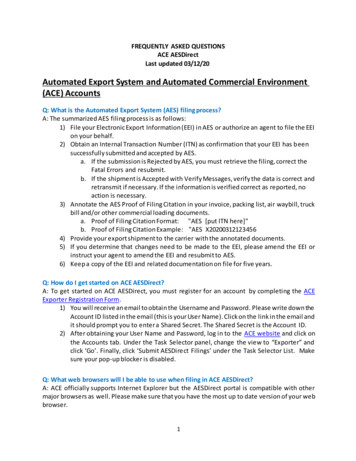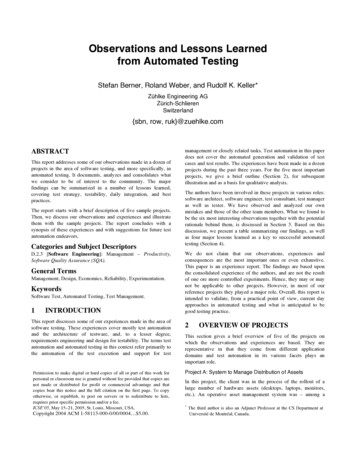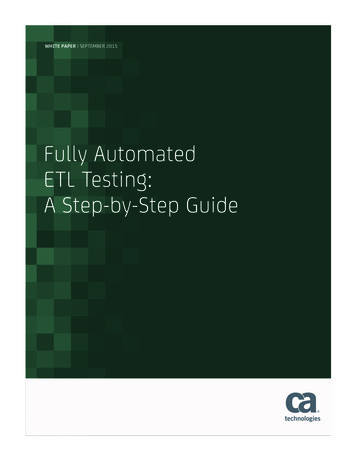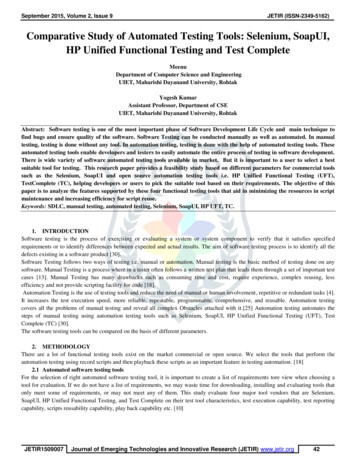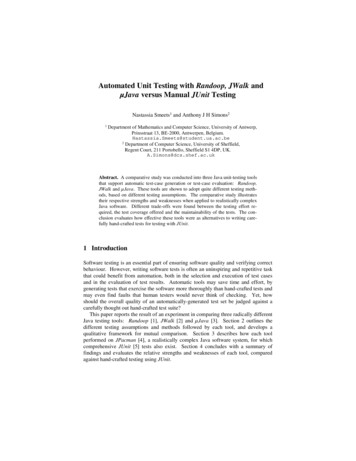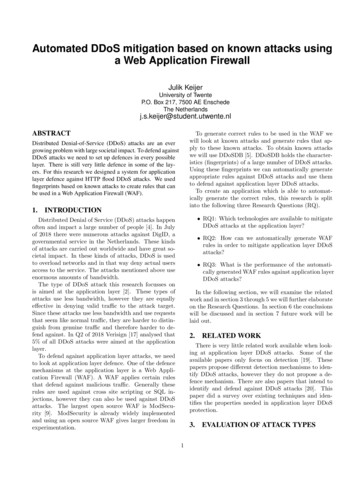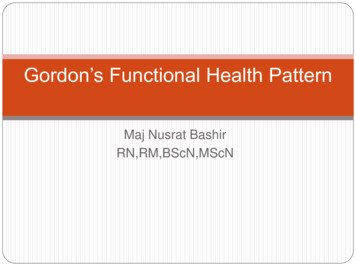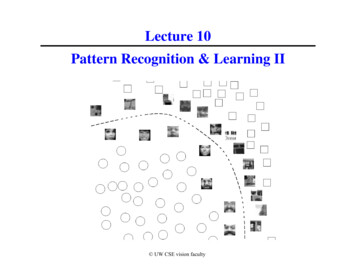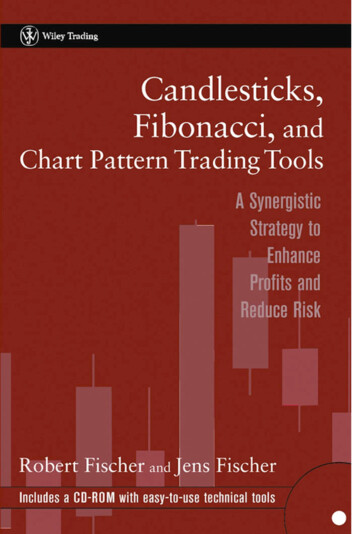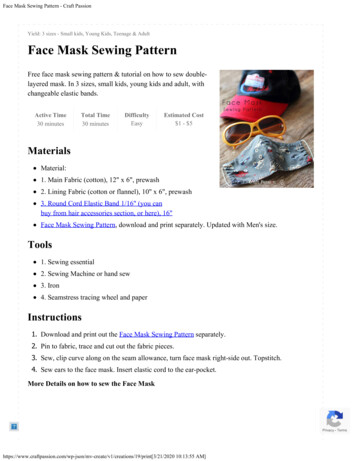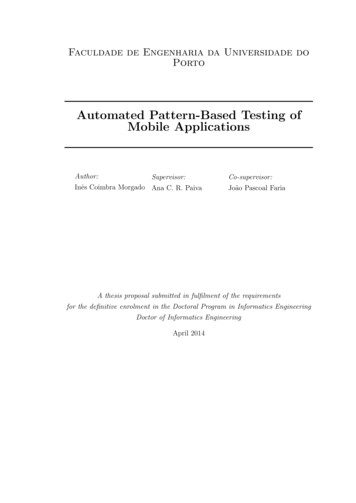
Transcription
Faculdade de Engenharia da Universidade doPortoAutomated Pattern-Based Testing ofMobile ApplicationsAuthor:Supervisor:Inês Coimbra Morgado Ana C. R. PaivaCo-supervisor:João Pascoal FariaA thesis proposal submitted in fulfilment of the requirementsfor the definitive enrolment in the Doctoral Program in Informatics EngineeringDoctor of Informatics EngineeringApril 2014
Universidade do PortoAbstractFaculdade de EngenhariaDepartmento de Engenharia InformáticaDoctor of Informatics EngineeringAutomated Pattern-Based Testing of Mobile Applicationsby Inês Coimbra MorgadoIn the last years the necessity to ensure the quality of mobile applications has increasedpartly due to the exponential increase of critical applications, such as e-banking, and, asfor every other type of software, test automation is an important step towards this goal.Testing the Graphical User Interface (GUI) of an application is equally important as itis through it that the user is going to interact with the application. One useful techniqueis model-based Graphical User Interface (GUI) testing as it automatically generates testcases based on a model of the application’s GUI. However, the manual construction ofsuch model is a time consuming error prone task. Reverse engineering can be useful toaid in the automatic generation of part of such model.One of the goals of this research work is to develop reverse engineering techniques andtools to obtain behavioral models of mobile applications’ GUIs. Even though eventdriven application, such as mobile ones, are a good target for dynamic exploration,static analysis may also be useful for identifying the widgets that have event handlersassociated.Since GUIs are usually designed based on common GUI patterns (combining structureand behavior), the reverse engineering process will be directed towards finding instancesof such patterns. This work is part of The Pattern-Based GUI Testing project which hasproved that it is possible to detect patterns on a system in order to ease its modelling andtesting as it is possible to define the corresponding test strategy prior to the exploration.As such, this work also intends to test the application on the fly whenever behaviourpatterns are identifying by running the corresponding test pattern on the application.
ContentsAbstractiContentsiiList of FiguresivList of TablesvAbbreviationsvi1 Introduction12 Related Work on Reverse Engineering2.1 Ontology for Classifying Reverse Engineering Approaches2.1.1 Goal . . . . . . . . . . . . . . . . . . . . . . . . . .2.1.2 Target . . . . . . . . . . . . . . . . . . . . . . . . .2.1.3 Method . . . . . . . . . . . . . . . . . . . . . . . .2.1.4 Information . . . . . . . . . . . . . . . . . . . . . .2.1.5 Output . . . . . . . . . . . . . . . . . . . . . . . .2.1.6 Validation . . . . . . . . . . . . . . . . . . . . . . .2.2 Software Reverse Engineering Approaches . . . . . . . . .2.3 Mobile Reverse Engineering Approaches . . . . . . . . . .2.4 Conclusions . . . . . . . . . . . . . . . . . . . . . . . . . .567891112131419223 Previous Work3.1 GUI Reverse Engineering for Visual and Formal Models3.2 Pattern-based GUI Reverse Engineering . . . . . . . . .3.3 Pattern-based GUI Testing . . . . . . . . . . . . . . . .3.4 Conclusions . . . . . . . . . . . . . . . . . . . . . . . . .23232629294 Approach and Methodology4.1 Definitions . . . . . . . . . .4.2 Approach . . . . . . . . . .4.2.1 Validation . . . . . .4.3 Research Hypothesis/Thesis4.4 Research Methodology . . .4.5 Work Plan . . . . . . . . . .30303233333334. . . . . . . . . . . . . . . .Statement. . . . . . . . . . .ii.
Contentsiii5 Conclusions36A Final Paper Selection on Reverse Engineering37B Geographical Distribution of the Selected Papers on Reverse Engineering39Bibliography44
List of Figures1.1Architecture of a reverse engineering process3.13.23.33.43.53.63.73.8Visual representation of a window graph . . . . . . . . . . . . . .Visual representation of a navigation graph . . . . . . . . . . . .Visual representation of a dependency graph . . . . . . . . . . .Architecture and outputs obtained in the RE process . . . . . . .Sample of the Spec# formal model generated . . . . . . . . . . .State machine in SMV . . . . . . . . . . . . . . . . . . . . . . . .Sample of the state machine with (a) and without (b) ambiguityArchitecture of the ILP approach . . . . . . . . . . . . . . . . . .4.14.2Activity lifecycle of an Android Activity [1] . . . . . . . . . . . . . . . . . 31Gantt chart of the work plan . . . . . . . . . . . . . . . . . . . . . . . . . 35iv. . . . . . . . . . . . . . . .32424252526272828
List of Tables2.12.22.32.42.52.62.72.8Classification of the approaches according to their goal . . . . . . . . . .Classification of the approaches according to their target . . . . . . . . .Classification of the approaches according to the method aspect . . . . .Classification of the technique according to the context in which it isapplied and of the approaches according to the techniques they use . . .Classification of the approaches according to the techniques used in thesecond phase of the reverse engineering process . . . . . . . . . . . . . .Classification of the approaches according to the output produced . . .Classification of the approaches according to how they were validated .Classification of the mobile RE approaches according to the ontology . .A.1 Final papers selection on software RE andpublished . . . . . . . . . . . . . . . . . . .A.2 Final papers selection on mobile RE and thelished . . . . . . . . . . . . . . . . . . . . .the venue where they. . . . . . . . . . . . .venue where they were. . . . . . . . . . . . . 14. 15. 16. 17.18181920were. . . . 38pub. . . . 38B.1 Geographical distribution of the research on software RE . . . . . . . . . 40B.2 Geographical distribution of the research on mobile RE . . . . . . . . . . 43v
AbbreviationsFSMFinite State MachineGUIGraphical User InterfaceMBGTModel Based GUI TestingMBTModel Based TestingPBGTPattern Based GUI TestingREReverse EngineeringSMVSymbolic Model VerificationUIUser InterfaceV&VVerification and Validationvi
Chapter 1IntroductionSince the release of the iPhone in 2007 [2] and of the first Android smart phone in 2008[3], smart phones have started to greatly increase their mobile sales. In fact, in late2013, smart-phones represented almost 60% of the mobile sales worldwide and, withAndroid and iPhone representing over 85% of the smart-phone sales [4]. Moreover,in mid-2013, Android’s Google Play reached one million available applications and thenumber of downloads has crossed the fifty billion threshold [5] and in late 2013 Appleannounced their App Store had also reached one million available applications and sixtybillion downloads [6]. This market dimension makes it extremely important to ensurethe quality of an application as it generates a high level of competitiveness and thus forone to get popular it must be as flawless as possible. Furthermore, there has also beenan increase of the critical mobile application, such as banking, which makes it even moreimportant to ensure its correctness.Mobile applications have, as any other type of application, their own quirks regardingtesting, such as the high amount of different events that need to be tested, and, as everyother, companies want to spend as little resources as possible in the testing process. Assuch, it is important to automate this process.Android already presents a tool to ease testing, Exerciser Monkey [7]. This is a fuzzytesting tool, i.e., it stress tests an Android application and its user interface (UI) bysending a pseudo-random stream of user events into the system. However, this does notensure the full testing of the application and it does not provide any coverage statistics.1
Chapter 1. Introduction2The academics have also been working on this, focusing mainly on Android applicationsand less on iOS ones. The main reasons for this are the increase of popularity of Androidand the availability of open-source applications and frameworks.The main focus of mobile testing is UI testing, more precisely Graphical UI (GUI)testing, as this is the source of interaction with the user and where most errors occur.There are two main focuses on mobile GUI testing in the literature: automatic test casegeneration and automatic crawling. The former provides a set of test cases that can berun on the application. The latter tries to exercise as many aspects of the applicationas possible in order to find errors, such as crashes. One of the most popular techniquesfor automatic test case generation is Model-based Testing (MBT) [8], i.e., it receivesa model of the application’s behaviour as input and outputs a test suite to be run onit. The problem of this technique is that it requires a model of the application andits manual construction is a time consuming and error prone task. As such, it is alsopreferable to automate this step as much as possible. There are several approachesfocusing this. However they usually target Desktop [9–14] or web [15–17] applications.Nevertheless, there are a few who apply Model Based GUI Testing (MBGT), i.e., MBTapplied to GUIs), to mobile applications [18–20]. Several of these approaches use reverseengineering techniques to ease the extraction of information and its abstraction into amodel.Reverse engineering (RE) was first defined in 1985 by Rekoff [21] as “the process ofdeveloping a set of specifications for a complex hardware system by an orderly examination of specimens of that system”. Five years later, Chikofsky and Cross [22] adaptedthis definition to software systems: “Reverse Engineering is the process of analysing asubject system to (1) identify the system’s components and interrelationships and (2) tocreate representations of the system in another form or at a higher level of abstraction”.Figure 1.1 depicts their representation of a common reverse engineering process.Even though nowadays reverse engineering is considered helpful in several areas [23], suchas testing, it initially surfaced associated with software maintenance as it eases systemcomprehension. This was considered extremely important as over 50% of a system’sdevelopment is occupied with maintenance tasks [24–26] and over 50% of maintenanceis dedicated to comprehending the system [27, 28].
Chapter 1. Introduction3Figure 1.1: Architecture of a reverse engineering processReverse engineering has also proved to be useful, for instance, in coping with the Y2Kproblem, with the European currency conversion and with the migration of informationsystems to the web and towards the electronic commerce [29]. With the exploration ofreverse engineering techniques, its usefulness grew from software maintenance to otherfields, such as verification and validation and security analysis.Even though reverse engineering techniques can also be used with malicious intents [30],such as removal of software protection and limitations or allowing unauthorised accessto systems/data, developers may also use the same techniques in order to improve thesoftware’s safety, e.g., auditing security and vulnerability.There has been some studies on applying reverse engineering techniques to mobile applications. Hu et al. [31] identify bugs in the application, Amalfitano et al. extract anevent-flow graph of the application considering [20] or not [32] system events, Joorabchiand Mesbah [33] and Yang et al. [34] extract a state machine relating the UI states withuser interactions.None of these approaches, however, try to take advantage of the existence of behaviouralpatterns in the application to facilitate their task. The pattern-based GUI testing(PBGT) project1 aims at improving current MBGT methods and tools, contributingto construct an effectively applicable testing approach in industry and to contribute tothe construction of higher quality GUIs and software systems. It is in the context ofthe PBGT project that this work arises. It is believed that mobile applications presentbehavioural patterns and that those ease the modelling and, thus, the testing task. Assuch, the work proposed in this document aims at extracting the behavioural model ofa mobile application and at testing it by defining test strategies to be applied on the1http://paginas.fe.up.pt/ apaiva/pbgtwiki/doku.php
Chapter 1. Introduction4fly as soon as a behavioural pattern is identified. During the exploration, whenever abehavioural pattern is detected a pre-defined test strategy will be applied to test it.Even though it is necessary to manually specify a catalogue of behavioural patterns andthe corresponding test strategies, the catalogue is common to every application.The remaining of this document is structured as follows. Chapter 2 presents the stateof the art in reverse engineering classifying it according to an ontology also presentedin this chapter. Chapter 3 presents some work that has already been done and thecorresponding results. Chapter 4 defines some useful concepts, describes the approachand the research methodology, states the research hypothesis and presents the workplan. Chapter 5 draws some conclusions.
Chapter 2Related Work on ReverseEngineeringTwo different analysis of related work were performed for this document. The aim ofthe first one was to provide a general overview of the current state of the art on reverseengineering, henceforth mentioned as software reverse engineering. Given the dimensionof this field of study, some restrictions for the selection of approaches were imposed. Assuch, the selection followed these steps:1. Selection of top conferences and journals on software engineering in the last sixyears (2008 to October 2013), i.e., conferences classified as CORE A and Journalsclassified as CORE A orA*1 (a total of thirteen venues)2. Selection of additional venues specific to reverse engineering and program comprehension in the last six years (2008 to October 2013)3. Selection of papers from the selected journals and conferences based on their titlesand abstracts: 104 papers initially selected4. Refinement of the selection regarding the paper’s content: 74 papers selectedThe second analysis regarded the state of the art on mobile reverse engineering. Themain differences from the software RE research methodology are: 1) only approaches1classification 5ResearchandEducation)ranking
Chapter 2. Related Work6targeting mobile applications were considered (approaches for mobile versions of webapplications were not taken into consideration); 2) an approach was considered regardlessof where it had been published; and 3) no time restriction was imposed. Regardless ofthe latter, all the approaches are recent as iOS and Android smart phones are also recent:the first iPhone was released in mid 2007 [2] and the first smart phone running Androidwas released in late 2008 [3].The final selection of papers for each venue is displayed in Tables A.1 and A.2 in Appendix A.Tables B.1 and B.2 in Appendix B present the geographical distribution of software andmobile reverse engineering research, respectively.2.1Ontology for Classifying Reverse Engineering ApproachesA careful analysis was performed to extract the most important aspects to classify theselected approaches. In order to do so an ontology was defined. This ontology was basedin the one presented by Cornelissen et al. [35]. The final list of the aspects consideredfor the classification consists on the following: goal : what is the main purpose of the approach? target: what is the target platform in which the approach works? method : what is the reverse engineering method used: static, dynamic, or hybrid? information: what type of information is extracted? (only for the mobile reverseengineering approaches) output: how is the obtained information represented to the user? validation: how is the proposed approach validated?In order to thoroughly classify all the different approaches, some aspects of the ontologywere refined for each of the selections (software and mobile reverse engineering): 1) thegoal, method, output and validation aspects are common to both classifications; 2) thetarget aspect has different possible values (in software RE it only matters if the target
Chapter 2. Related Work7application is, for instance, web or mobile while in mobile RE it verifies if the applicationis for the iOS or the Android system); 3) the information aspect is only present in themobile RE analysis as most approaches do not specify which specific information theyare interested in even though such was stated in the mobile RE ones.For each of the mentioned aspects, there are different sub-classifications. The nextsections define each of these classifications.2.1.1GoalFeature Location: A feature is usually any specific scenario of a system that is triggeredby an external user [36]. A feature location approach extracts information on whichmethods and classes implement a certain feature. Most feature location approachesdistinguish between feature specific methods, i.e., methods that are only used by onefeature, and omnipresent methods, i.e., methods that are used by several features.Pattern Identification: The concept of pattern was first defined by an architect, Christopher Alexander [37], as a representation of the “current best guess as to what arrangement of the physical environment will work to solve the problem presented”. In the software engineering area, the definition of a pattern is conceptually the same but appliedto the context of software engineering. Usually, design patterns are the ones considered[38]. Nevertheless, some approaches explore other types of patterns, such as behaviouralor communication ones.Model Recovery: Model recovery intends to recover a model, i.e., a representation of(part of) a system. There are usually three kinds of information represented in thesemodels: software architecture, business processes and system configuration. Nevertheless, it is possible to find other approaches extracting information such as layout orbehavioural dependencies. Every approach whose sole purpose is to recover (extract) amodel of a system without revealing any further purposes fits into this category.Verification and Validation: Verification and Validation (V&V) processes are used todetermine whether the development products of a given activity conform to the requirements of that activity and whether the product satisfies its intended use and user needs.Verification and Validation life cycle process requirements are specified for different integrity levels. Its scope encompasses systems, software, and hardware, and it includes
Chapter 2. Related Work8their interfaces [39]. In reverse engineering approaches, the two main sub-fields of V&Vfocused are Testing, such as generating a test suite, and Security as in ensuring, forinstance, the application does not unwillingly access any user data.Migration: Migration involves moving a set of instructions or programs from one platformto another. It may be motivated by different reasons such as the obsolescence of atechnology, the pressure of users or the need to build a single coherent informationsystem when merging companies [40]. This is usually important when dealing withlegacy systems as it is often too costly to manually migrate the system or to build a newone. This classification was given to approaches which stated it as such.Maintenance: Software maintenance is the modification of a software product after delivery to correct faults or to improve performance or other attributes [41]. Although inmany cases the maintenance of a system may
Testing the Graphical User Interface (GUI) of an application is equally important as it is through it that the user is going to interact with the application. One useful technique is model-based Graphical User Interface (GUI) testing as it automatically generates test cases based on
